Overhead refers to the ongoing costs of running a business that are not directly related to creating or selling a product or service. It includes expenses like rent, utilities, office supplies, repairs or maintenance, insurance, taxes, and so on. Knowing these costs is important for budgeting because it reflects the minimum income a business must earn to break even, even if they don't make or sell any products. For example, if a business' overhead costs for a month are $50,000, then the company's owners know that the business must earn a minimum of $50,000 in revenue just to cover the cost of doing business. Overhead costs are generally fixed, although some may be variable with the level of production. For example, if a company goes from running a factory only during business hours to running the factory 24/7, then the cost of utilities will go up. These include expenses related to administration, utilities, insurance, and rental costs, among others. Unlike direct costs, such as raw materials or labor directly involved in manufacturing a product or providing a service, overhead costs are indirect. They contribute to the enabling environment where the business operations take place but are not attributed to any specific product or service. Fixed overheads are expenses that remain consistent, regardless of the volume of goods or services a company produces. They are termed "fixed" as they do not change significantly over a certain period or level of production. These costs include rent for office space, salaries of permanent staff, and insurance. Fixed overheads are the backbone of a company's operations, providing the necessary stability during times of fluctuation in production or service provision. Yet, while these costs offer predictability and stability, they also pose a challenge. Their unchanging nature can put a strain on a company's finances, particularly during periods of low productivity or economic downturn. Businesses must manage their fixed overheads carefully to maintain a healthy balance between profitability and continuity. On the other hand, variable overheads are costs that fluctuate in tandem with the level of output or production. These can include utilities like electricity, raw materials, or temporary labor costs that increase or decrease as the business ramps up or scales down its operations. The inherent flexibility of variable overheads makes them an important lever for organizations to manage their financial efficiency. The variable nature of these costs does, however, introduce a degree of unpredictability into financial planning. The exact amount of variable overheads can be hard to predict, particularly in industries where output fluctuates greatly. Consequently, businesses must constantly monitor and adjust their spending on variable overheads to ensure financial efficiency. Semi-variable overheads, as the term suggests, combine the characteristics of both fixed and variable overheads. They contain a fixed component, which must be paid regardless of output levels, and a variable component that changes with production volume. Examples include a telephone bill that has a fixed subscription charge plus costs that vary with usage, or a vehicle cost that includes a fixed depreciation and insurance cost, with variable fuel and maintenance costs. The dual nature of semi-variable overheads necessitates a keen understanding of both their fixed and variable components. Businesses must identify and quantify these to make accurate financial forecasts and informed decisions. The challenge lies in segregating the fixed and variable elements accurately, as they often present themselves as a single cost entity. The direct allocation method involves assigning overhead costs directly to each department within an organization based on their utilization or requirement of overhead resources. These could be allocated based on various parameters like the number of employees, floor space occupied, or machine hours used. This approach is relatively straightforward and simple to implement. However, the simplicity of the direct allocation method can also be its downfall. It often fails to account for the complexity of modern businesses, where departments interact and resources are shared. For example, it does not account for the overhead costs of the human resources department providing services to multiple departments, often resulting in an oversimplification of the cost structure. The step-down allocation method, or sequential allocation method, is a slightly more sophisticated approach. It acknowledges the interdepartmental provision of services within an organization. Under this method, service departments that provide support to other service departments allocate their overhead costs in a sequence. This sequence usually starts with the department providing the most services to others and ends with the one providing the least. While this method provides a more realistic allocation of costs, it still has its limitations. The step-down method assumes a one-way flow of services and does not consider reciprocal services between departments. It can also be challenging to determine the order of allocation between departments, leading to potential disagreements or inaccuracies. The reciprocal allocation method, as the name implies, accounts for the reciprocal nature of services provided among departments. This method recognizes that service departments not only provide services to production departments but also to each other, creating a network of inter-departmental services. The costs are allocated proportionally based on the level of reciprocal services provided. Although this method provides the most accurate overhead allocation, it is also the most complex to implement. It requires a high level of data granularity and advanced calculations, which might not always be feasible for all organizations. Despite its complexity, the reciprocal allocation method provides a comprehensive picture of overhead costs, making it a valuable tool for effective decision-making. An overhead budgeting process often starts with the analysis of historical data. This involves reviewing past overhead expenses to identify trends, patterns, and outliers. By studying these patterns, companies can forecast future overhead costs with a greater degree of accuracy. This, in turn, can guide strategic decision-making and ensure more effective control over costs. However, the use of historical data has its challenges. It assumes that past patterns will continue into the future, which may not always be the case. Changes in business operations, market conditions, and technological advancements can significantly alter overhead costs. Therefore, while historical data provides valuable insights, it should not be used in isolation. After analyzing historical data, the next step is to identify the cost drivers. Cost drivers are the various factors that cause overhead costs to increase or decrease. Examples can include the number of employees, units produced, or the amount of time spent on certain activities. By identifying these cost drivers, companies can better understand what influences their overheads and subsequently find ways to control these drivers to manage costs effectively. Identifying cost drivers accurately can be challenging, given the multifaceted nature of overheads. It requires a deep understanding of business operations and the factors that influence costs. Nevertheless, the identification of cost drivers is a crucial step in the overhead budgeting process as it offers strategic insights into cost control. The final step in the overhead budgeting process is setting budget targets. This involves determining the maximum amount that a company is willing to spend on overheads for a given period. These targets should be set with consideration to the company's financial position, strategic objectives, and the insights gained from the analysis of historical data and identification of cost drivers. Setting overhead budget targets is a delicate balancing act. Set them too high, and the company risks overspending and compromising its financial health. Set them too low, and the company may not be able to maintain its operations effectively. Careful consideration of multiple factors is thus critical in setting realistic and effective overhead budget targets. The effective control of overhead costs can lead to significant cost reductions and efficiency improvements. By understanding and managing overheads, businesses can identify inefficiencies, eliminate unnecessary expenditures, and optimize the use of resources. This results in not just financial savings but also improved operational efficiency, contributing to a leaner and more agile organization. However, cost reduction and efficiency improvement are not about indiscriminate cost-cutting. It requires a careful evaluation of the value and impact of each overhead cost. This is to ensure that in the pursuit of cost reduction, the company does not compromise the quality of its products or services, or its ability to operate effectively. Overhead control also has a direct impact on a company's profitability and competitiveness. Lower overhead costs mean higher profit margins, providing the company with greater financial flexibility. This can enable the company to invest in growth initiatives, withstand market downturns, or offer competitive pricing to its customers. The relationship between overhead control and competitiveness extends beyond just financial considerations. It can also contribute to a company's reputation for efficiency and effective management, enhancing its standing among customers, investors, and competitors. However, like cost reduction, the pursuit of profitability should not undermine the company's long-term sustainability and growth prospects. It involves comparing actual overhead costs with budgeted or standard costs to identify any variances. These variances can then be analyzed to identify their causes, which can inform corrective actions and future budgeting decisions. While overhead variance analysis provides valuable insights, it is only as good as the data and assumptions it is based on. Inaccurate data or unrealistic budget standards can lead to misleading variances and incorrect conclusions. Therefore, the success of variance analysis depends on the accuracy of data and the reasonableness of the budgets or standards used. This involves reviewing and streamlining business processes to eliminate inefficiencies and reduce waste. Process optimization can include measures such as improving workflow design, standardizing procedures, and implementing quality control measures. While process optimization can lead to significant cost reductions, it requires a deep understanding of business processes and the ability to identify and implement improvements. It also requires a culture of continuous improvement and a willingness to change established ways of doing things. Despite these challenges, process optimization is a powerful tool for enhancing efficiency and reducing overhead costs. The implementation of technology can also contribute significantly to overhead reduction. Technologies such as automation, artificial intelligence, and cloud computing can streamline operations, improve efficiency, and reduce manual and repetitive tasks, thereby lowering overhead costs. Technology can also provide better data and analytics capabilities, enabling more informed decision-making and more effective management of overheads. However, the implementation of technology also involves costs and challenges. These can include the cost of the technology itself, implementation costs, and the need for training and change management. Therefore, the decision to implement technology should be based on a careful cost-benefit analysis and a clear understanding of its potential impact on overhead costs. Effective resource allocation and streamlining is another important strategy for reducing overhead costs. This involves ensuring that resources are used efficiently and that unnecessary or redundant resources are eliminated. Resource allocation and streamlining can also involve outsourcing or offshoring certain functions to reduce costs. However, resource allocation and streamlining should not be approached as a simple cost-cutting exercise. It requires a strategic view of resource needs and the value that different resources contribute to the business. Care should also be taken to ensure that resource reductions do not compromise the quality of products or services or the ability of the business to operate effectively. Overhead costs are recorded on a company's income statement. Overhead is often segmented into different categories. Administrative overhead can apply to the accountants, human resources representatives, and managers needed to run the business. Selling overhead applies to the cost of selling goods or services, such as marketing and advertisements. Overhead refers to the ongoing expenses incurred in running a business that are not directly tied to the creation or sale of a product or service. These expenses encompass various items such as rent, utilities, office supplies, maintenance, insurance, and taxes. Understanding and effectively managing overhead is crucial for budgeting and achieving profitability. Fixed overhead costs provide stability but can strain finances during periods of low productivity. Variable overhead costs fluctuate with production levels and offer flexibility but require constant monitoring. Semi-variable overhead costs combine fixed and variable components and necessitate accurate identification for financial forecasts. Overhead allocation methods, such as direct, step-down, and reciprocal allocation, provide different levels of accuracy and complexity. The overhead budgeting process involves historical data analysis, identifying cost drivers, and setting realistic budget targets. Controlling overhead costs leads to cost reduction, efficiency improvement, increased profitability, and enhanced competitiveness. Overhead variance analysis allows for corrective actions and informed decision-making.Overhead Definition
Define Overhead in Simple Terms
Types of Overhead
Fixed Overhead
Variable Overhead
Semi-variable Overhead
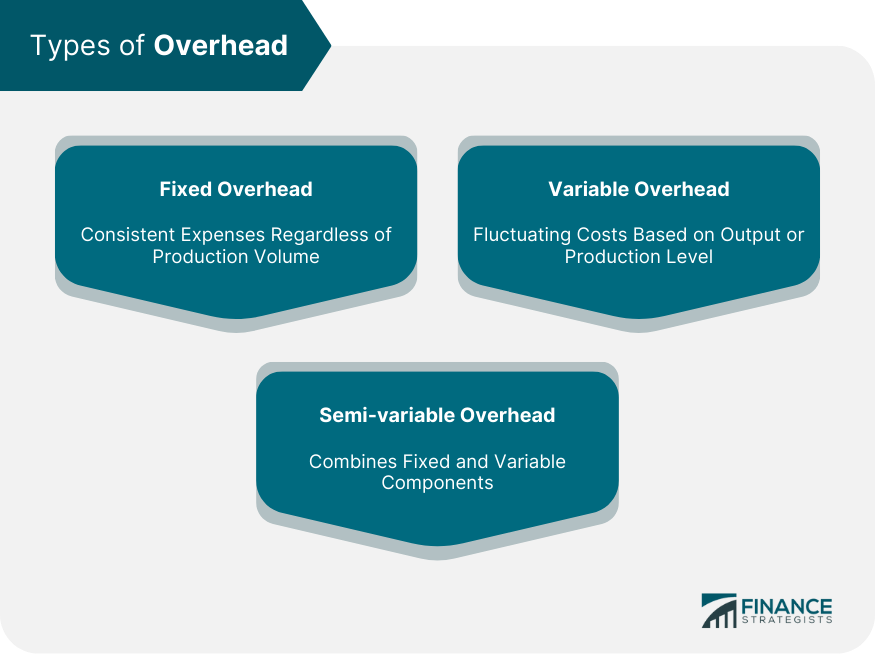
Overhead Allocation Methods
Direct Allocation
Step-Down Allocation
Reciprocal Allocation
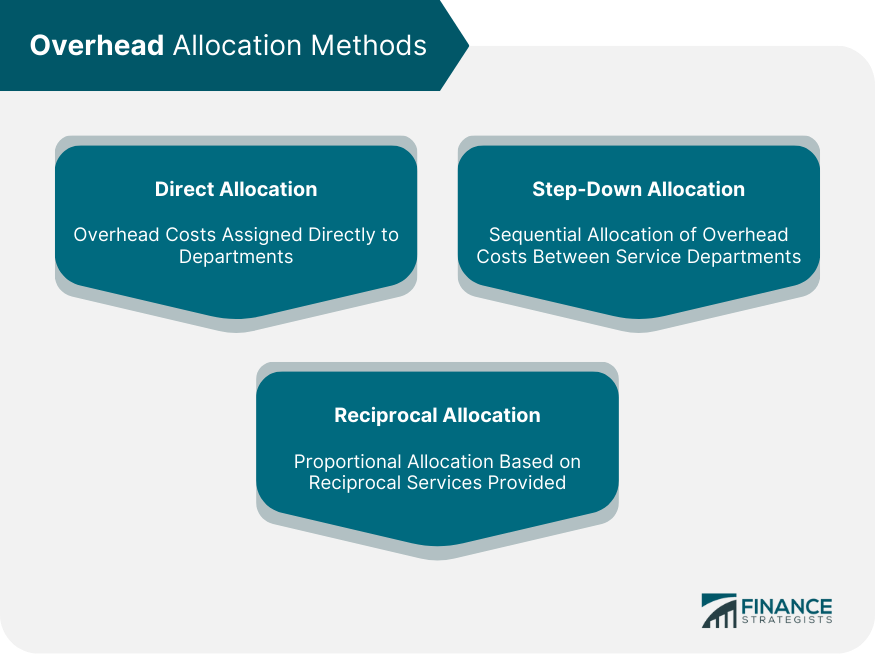
Overhead Budget Process
Historical Data Analysis
Identify Cost Drivers
Set Overhead Budget Targets
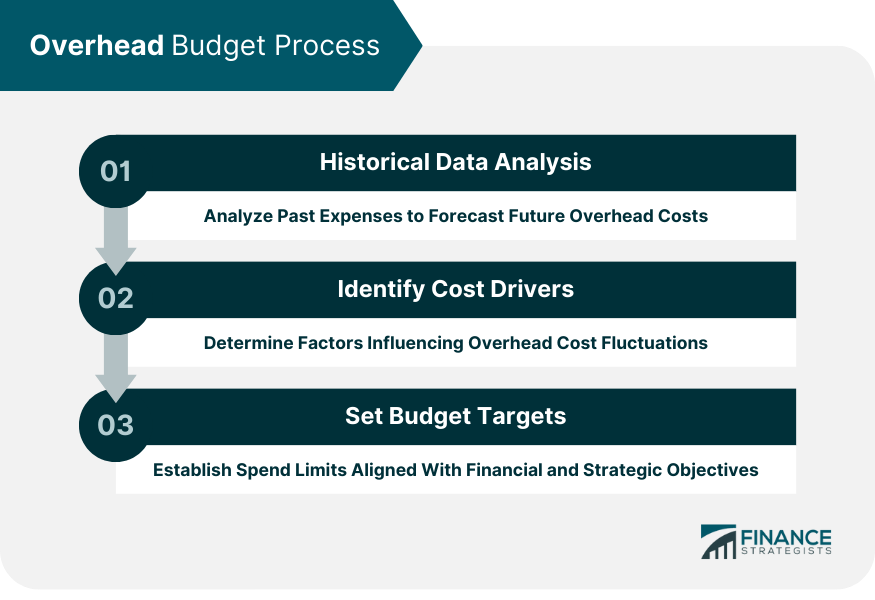
Significance of Overhead Control
Cost Reduction and Efficiency Improvement
Profitability and Competitiveness
Overhead Variance Analysis
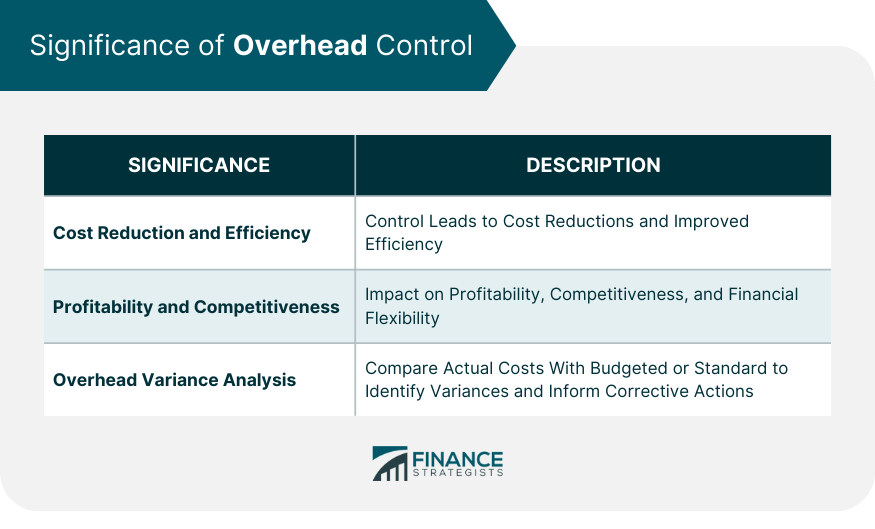
Overhead Reduction Strategies
Process Optimization
Technology Implementation
Resource Allocation and Streamlining
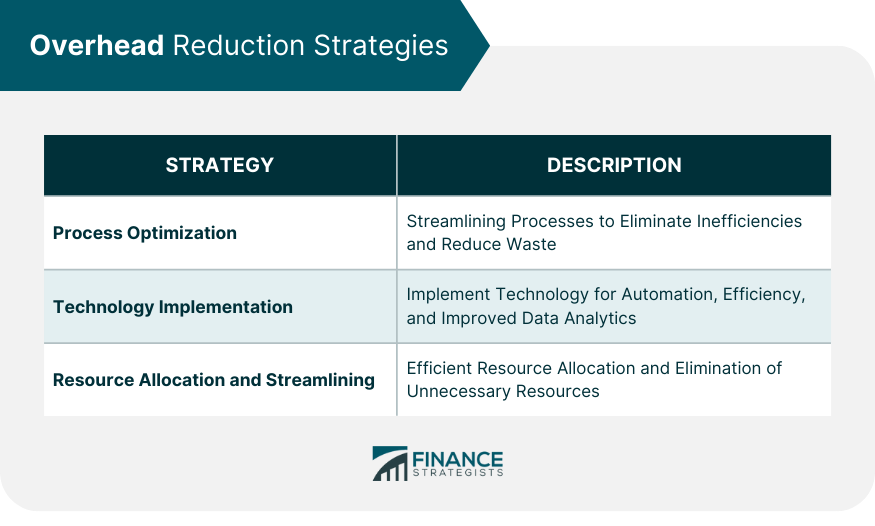
Overhead Example
Conclusion
Overhead FAQs
Overhead refers to the ongoing costs of running a business that are not directly related to creating or selling a product or service.
Overhead includes expenses like rent, utilities, office supplies, repairs or maintenance, insurance, taxes, and so on.
Knowing these costs is important for budgeting because it reflects the minimum income a business must earn to break even, even if they don’t make or sell any products.
If a business’ overhead costs for a month are $50,000, then the company’s owners know that the business must earn a minimum of $50,000 in revenue just to cover the cost of doing business.
Administrative overhead can apply to the accountants, human resources representatives, and managers needed to run the business. Selling overhead applies to the cost of selling goods or services, such as marketing and advertisements.
True Tamplin is a published author, public speaker, CEO of UpDigital, and founder of Finance Strategists.
True is a Certified Educator in Personal Finance (CEPF®), author of The Handy Financial Ratios Guide, a member of the Society for Advancing Business Editing and Writing, contributes to his financial education site, Finance Strategists, and has spoken to various financial communities such as the CFA Institute, as well as university students like his Alma mater, Biola University, where he received a bachelor of science in business and data analytics.
To learn more about True, visit his personal website or view his author profiles on Amazon, Nasdaq and Forbes.















